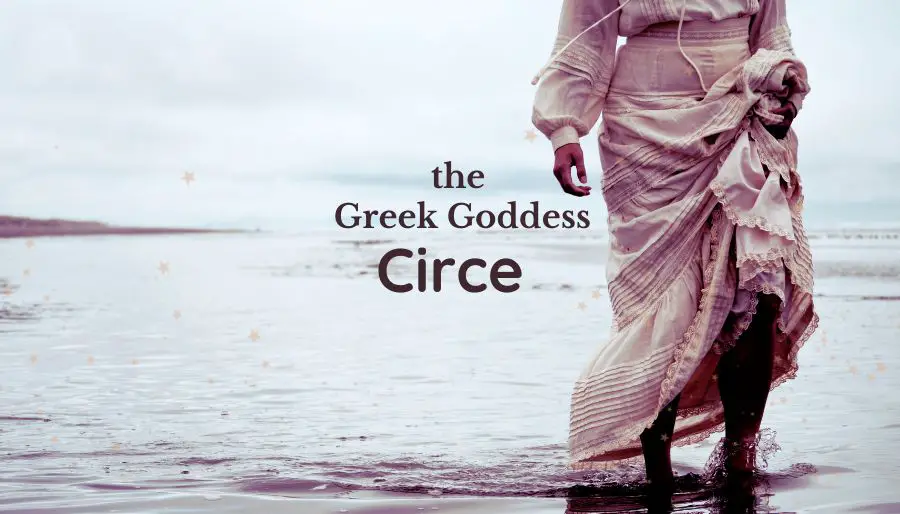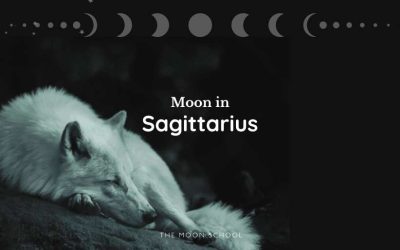Circe is a well-known figure in Greek mythology, often depicted as a powerful sorceress or enchantress.
Known for her vast knowledge of magical potions and herbs, and ability to transform men into animals, Circe is a figure to be reckoned with.
Circe’s story is one of the most intriguing in Greek mythology. Her character has been the subject of many adaptations and retellings throughout history.
From her origins as a minor goddess to her portrayal as a powerful sorceress, Circe remains a fascinating figure in mythology.
She continues to inspire women, igniting fascination in the magic and allure of the dark feminine mysteries.
Who is the Greek Goddess Circe?
Circe, is a minor goddess of ancient Greek mythology. Born to the sun god Helios and the oceanid nymph Perse, her parents were both powerful and influential figures in Greek mythology.
Circe’s early life is shrouded in mystery, with little information available about her childhood. However, it is believed that she spent most of her formative years in the company of her mother, who was known for her wisdom and knowledge of the natural world.
As the daughter of Helios, Circe was born with the ability to harness the power of the sun. This gave her a unique advantage over other mortals and made her a force to be reckoned with in the world of Greek mythology.
Despite her divine heritage, Circe was not immune to the trials and tribulations of mortal life. She experienced many of the same struggles and challenges that other mortals faced, including love, loss, and betrayal.
As she grew older, Circe’s powers and knowledge of magic continued to develop, making her one of the most powerful sorceresses in all of Greek mythology.
Her reputation for using her magic to transform humans into animals and other creatures became the stuff of legend, cementing her place in the pantheon of Greek gods and goddesses.
What are the powers, strengths, and abilities of Circe?
Circe was a powerful goddess with a wide range of abilities. She was known for her knowledge of witchcraft and sorcery, as well as her expertise in herbs and magic potions.
Witchcraft and Sorcery
Circe was a skilled practitioner of witchcraft and sorcery. She was able to cast spells and incantations to manipulate reality and bend it to her will.
Yet Circe’s magic was not limited to simple spells and incantations. She was also able to create powerful magical artifacts, such as her magic wand, which she used to direct her energy towards her targets, often unleashing devastating attacks.
Knowledge of Herbs and Potions
Circe was also known for her vast knowledge of herbs and potions. She was able to concoct powerful elixirs and brews that could heal or harm, depending on her intentions.
Circe’s knowledge of herbs and potions was not limited to their effects on the body. She was also able to use them in her magical rituals, enhancing her spells and incantations with their mystical properties.
Immortality
As a goddess, Circe is immortal and does not age or die.
Shape-shifting
Circe has the ability to transform herself and others into different forms, including animals and inanimate objects.
Persuasion
Circe is a master at persuasion and can easily manipulate the minds of others to get what she wants.
Healing
Despite her reputation as a sorceress, Circe is also known for her healing abilities, especially when it comes to medicinal herbs and potions.
Telekinesis
In some myths, Circe is said to have the ability to move objects with her mind, demonstrating her mastery over magic and the elements.
Selene’s family and siblings
Circe’s father was Helios, the Titan sun god who was also known as the god of sight.
Her mother was Perse, an ocean nymph.
According to some versions of the myth, she was one of three thousand daughters of Titans Oceanus and Tethys.
In contrast, other sources suggest that Circe was the daughter of the queen of witches and goddess of sorcery, Hecate.
Circe also had two siblings. Her brother was Aeetes, who was the king of Colchis and the keeper of the Golden Fleece.
Her sister was Pasiphae, wife of King Minos of Crete and the mother of the Minotaur.
What is the myth of Circe and Odysseus?
In Greek mythology, Circe is best known for her encounter with Odysseus, described in Homer’s Odyssey, the epic poem.
According to the Greek myth, Odysseus and his men were sailing home to Ithaca after the Trojan War when they came upon Circe’s island, Aeaea.
In some myths, Circe’s singing was so beautiful that it would lure sailors in on their boats.
The men were exhausted and hungry, so leaving Odysseus on the boat, they went ashore to explore.
It’s said that when they reached the gates of the goddess’s house they could hear Circe within, singing most beautifully with her human speech as she worked at her loom. They could see Circe surrounded by many creatures, including lions and wolves.
The beautiful Goddess Circe, with her long braided hair, greeted them with her usual charm and offered them food and drink.
However, the food and drink were laced with magic potions, and soon Odysseus’s men were transformed into beastly forms.
One of Odysseus’ men called Eurylochus managed to run back to the ship to warn his captain, who then raced inland to try to save them.
But on the way the messenger God Hermes warned Odysseus of Circe’s strange powers, and gave him the magic herb moly, so he’d able to resist Circe’s powerful spell.
Odysseus demanded that Circe restore his men to their human form.
Impressed by his bravery and intelligence, she complied.
The goddess then purified him and Circe invited him into her bed. At first he he refused, as he was still in love with his wife Penelope. Yet Odysseus did end up staying on her island for a year, during which time he fathered three sons with her.
When he finally left, she gave him advice on how to avoid the dangers that lay ahead on his journey home.
Odysseus’ encounter with Circe, and their subsequent love is a complex aspect of the story. Some interpretations suggest that she genuinely loved him, while others argue that she was simply using him for her own purposes.
Residence on the Island of Aeaea
Circe the sorceress in Greek mythology, is known for her residence on the island of Aeaea. The island was said to be populated by various animals, including wolves, lions, and other beasts, which were presumably her transmogrified victims.
Circe’s arrival on Aeaea is shrouded in mystery.
According to some sources, Circe was banished to the mythical island after she transformed Scyllus into a monster (see below).
Others say Circe washed up on Aeaea after she was exiled from her home in Colchis for murdering her husband. On the brink of death, she met Hecate, who offered Circe a fifth of her own soul known as a ‘Witchmark,’ which Circe accepted and swiftly began to use to her advantage.
The location of Aeaea is not entirely clear, with Homer being vague about its whereabouts. However, in his epic poem Argonautica, the author Apollonius of Rhodes locates Aeaea somewhere south of Aethalia (Elba), within view of the Tyrrhenian shore (that is, the western coast of Italy).
The myth of Glaucus
Another notable myth involving Circe is her encounter with Glaucus, a sea god. According to the story, Glaucus was in love with the nymph Scylla, but she rejected him. In his despair, he sought out the advice of Circe, asking the witch for a potion to make Scylla fall in love with him.
Circe, however, fell in love with Glaucus herself and tried to use both magical potions and enchantments to win him over. She created a potion that would make Glaucus fall in love with her, but he accidentally spilled it on himself while trying to catch a fish. He continued to scorn her, so in revenge, Circe poisoned the pool where Scylla was bathing, transforming her into a terrible monster.
Jason and the Argonauts
In the Argonautica, Circe played a crucial role in the story of Jason and the Argonauts. She purified Jason and Medea after they murdered the Colchian prince Apsyrtus. This allowed them to continue their journey with a clear conscience and without the wrath of the gods upon them.
Circe’s involvement in the Argonautica is significant because it highlights her knowledge of magic and her ability to use it for both good and evil. While she was known for turning men into animals, she also had the power to purify and heal.
Circe Goddess associations and symbols
As a minor, yet powerful Goddess in the Greek pantheon, Circe has some symbolic associations that have endured to the present day. Here are a handful of her most common symbols –
Magic wand: Circe is often depicted holding a magic wand, which represents her magical abilities and power.
Pigs: Circe is associated with pigs because she turned some of the men who visited her island into pigs.
Poisonous plants: In some stories, Circe is said to have used poisonous plants and herbs in her magic. These plants are sometimes depicted as symbols of her power.
Crown of flowers: Circe is often associated with flowers, and shown wearing a crown of flowers. This represents her connection to nature and the natural world.
The Moon: The Goddess Circe is sometimes associated with the Moon. As a symbol of the divine feminine mysteries, the Moon has long been connected to magic and witchcraft.
Want to know more about Goddesses of the Moon?
Read this post next – A Complete List of Moon Goddesses from Around the World
Goblet: In some depictions (most notably Circe Offering the Cup to Ulysses, the 1891 oil painting by Pre-Raphaelite painter John William Waterhouse) Circe is shown holding a goblet. This represents her ability to control and manipulate those who drink from it.
Serpents: Circe is sometimes associated with serpents, which are often depicted as symbols of transformation and renewal.
Hawks: Circe is associated with hawks. Some historians believe her name comes from the word kirkos, or circle, which describes the spiraling flight pattern of the hawk. Some even call her “the circling one” or “She-falcon”.
Mirror: In some stories, Circe is said to have used a mirror to cast her spells. The mirror is sometimes depicted as a symbol of her ability to reflect and manipulate reality.
Lions: In some Greek mythology Circe is described as surrounded by lions. Associated with strength and power, these powerful animals may also represent her connection to the natural world and her ability to shapeshift and transform men.
What are some modern interpretations of Circe’s mythology and symbolism?
As a powerful figure in ancient Greece, Circe’s legacy lives on, well into the modern day.
Many still call on Circe Goddess of strength, power and transformation as an icon for women today.
Circe in female spirituality
As an expert in witchcraft, herbalism, plant magic, potions, and enchantments of all kinds, the Goddess Circe is often called upon by modern magical women. Those seeking guidance and direction on the path of advanced magic find Circe’s power and influence invaluable.
Circe as a Feminine Icon
Some modern feminist interpretations of Circe’s story focus on her status as a powerful woman in a male-dominated society. These interpretations often emphasize her ability to control and manipulate men, and to break free from paradigms of control.
Do you want to work with your feminine energy?
Check out some of these posts next –
Circe as psychological inspiration
Some modern interpretations of Circe’s story focus on the psychological aspects of her character. These interpretations often explore themes of transformation, self-discovery, and personal growth.
Circe as a literary influence
Circe’s story has been reimagined and retold in various works of literature, including Madeline Miller’s “Circe” and Margaret Atwood’s “The Penelopiad.” These works often explore themes of power, identity, and gender.
Circe in pop culture
Circe’s story and symbolism have been referenced in various forms of popular culture, including movies, TV shows, and even video games. These interpretations often emphasize her magical abilities and her connection to the natural world.










